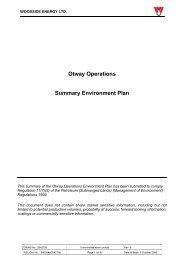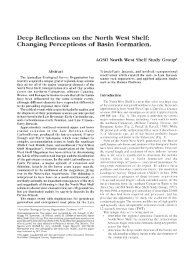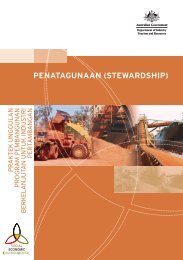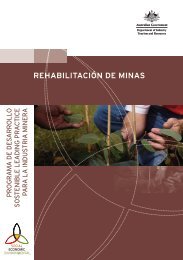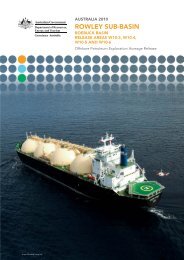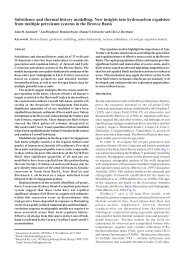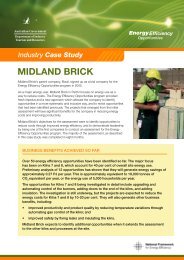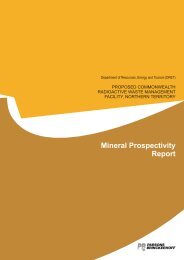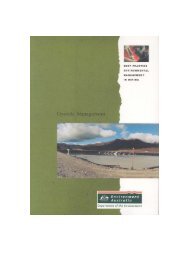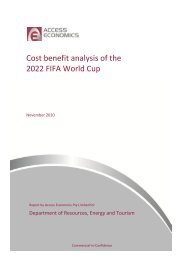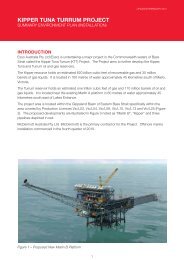A guide to leading practice sustainable development in mining
A guide to leading practice sustainable development in mining
A guide to leading practice sustainable development in mining
You also want an ePaper? Increase the reach of your titles
YUMPU automatically turns print PDFs into web optimized ePapers that Google loves.
Although drill<strong>in</strong>g and sampl<strong>in</strong>g will focus on ore zones <strong>in</strong> the exploration and<br />
pre-feasibility phase, samples of host and country rock should be <strong>in</strong>creas<strong>in</strong>gly<br />
represented as the project develops so that adequate data are available <strong>to</strong> produce<br />
block models and production schedules by geochemical waste types.<br />
Key sampl<strong>in</strong>g <strong>guide</strong>l<strong>in</strong>es are listed below (Scott et al., 2000):<br />
Drill core and percussion chip samples should represent no more than 10<br />
metre <strong>in</strong>tervals and cover <strong>in</strong>dividual geological types and ore types.<br />
Each composite sample should not be obta<strong>in</strong>ed from more than one drill hole.<br />
Each sample should be approximately 1-2 kg. The sample should be crushed <strong>to</strong><br />
nom<strong>in</strong>al 4 mm size, then riffle split <strong>to</strong> produce 200-300 g for pulveris<strong>in</strong>g <strong>to</strong> m<strong>in</strong>us<br />
75 micron. The m<strong>in</strong>us 4 mm and pulverised splits should be reta<strong>in</strong>ed for test<strong>in</strong>g.<br />
Pre-m<strong>in</strong><strong>in</strong>g<br />
Few m<strong>in</strong>eral resources are homogeneous and relatively little is unders<strong>to</strong>od about<br />
them and their host rocks <strong>in</strong> the pre-m<strong>in</strong><strong>in</strong>g phases. However, it is important dur<strong>in</strong>g<br />
the pre-m<strong>in</strong><strong>in</strong>g phases that the project team, <strong>in</strong>clud<strong>in</strong>g geologists, m<strong>in</strong>e planners,<br />
environmental scientists and AMD experts, ensures that an adequate geological and<br />
geochemical database is compiled <strong>to</strong> clarify basel<strong>in</strong>e conditions and the risk of AMD.<br />
A typical progressive test work program is summarised <strong>in</strong> Table 3. Knowledge of the<br />
likely wastes that will be generated and materials exposed and the constra<strong>in</strong>ts that<br />
these will place on the m<strong>in</strong><strong>in</strong>g operation is vital (Scott et al., 2000).<br />
A detailed Closure Plan needs <strong>to</strong> be developed and costed for a site dur<strong>in</strong>g the<br />
feasibility phase. This must rema<strong>in</strong> a “liv<strong>in</strong>g document”, as the m<strong>in</strong>e proceeds,<br />
with regular reviews and updates based on new technologies, stakeholder <strong>in</strong>puts,<br />
chang<strong>in</strong>g m<strong>in</strong>e conditions and community expectations.<br />
Moni<strong>to</strong>r<strong>in</strong>g Purpose<br />
The ma<strong>in</strong> purpose of an AMD moni<strong>to</strong>r<strong>in</strong>g program is <strong>to</strong> provide relevant <strong>in</strong>formation<br />
that can be used by site planners and managers as a basis for <strong>in</strong>formed decision<br />
mak<strong>in</strong>g. An effective moni<strong>to</strong>r<strong>in</strong>g program will facilitate the implementation of an<br />
AMD Management Plan for the site that can reduce or elim<strong>in</strong>ate the impacts of AMD<br />
on the environment, community and m<strong>in</strong><strong>in</strong>g operations.<br />
48 LEADING PRACTICE SUSTAINABLE DEVELOPMENT PROGRAM FOR THE MINING INDUSTRY






